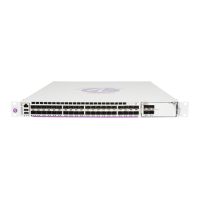Configuring VPRN Components
Page 430 7705 SAR OS Services Guide
interface "if3"
address 11.11.11.1/24
port 1/1/35
exit
...
#------------------------------------------
ALU48>config>router#
Configuring BGP for VPRN
Configuring BGP between the PE routers allows the PE routers to exchange information
about routes originating and terminating in the VPRN. The PE routers use the information to
determine which labels are used for traffic intended for remote sites.
BGP is configured under the config>router>bgp context. For more information about
the BGP protocol, refer to the “BGP” section in the 7705 SAR OS Routing Protocols Guide.
Configuring Route Reflection
Route reflection can be implemented in autonomous systems with a large internal BGP mesh
to reduce the number of IBGP sessions required. One or more routers can be selected to act
as focal points for internal BGP sessions. Several BGP-speaking routers can peer with a
route reflector. A route reflector forms peer connections to other route reflectors. A router
assumes the role as a route reflector by configuring the cluster cluster-id
command. No other command is required unless you want to disable reflection to specific
peers.
If you configure the cluster command at the global level, then all subordinate groups and
neighbors are members of the cluster. The route reflector cluster ID is expressed in dotted-
decimal notation. The ID should be a significant topology-specific value.
If a route reflector client is fully meshed, the disable-client-reflect command can
be enabled to stop the route reflector from reflecting redundant route updates to a client.
Configuring a VPRN Interface
Interface names associate an IP address with the interface, and then associate the IP interface
with a physical port. The logical interface can associate attributes like an IP address, port, or
the system. There are no default interfaces.
Refer to VPRN Services Command Reference on page 439 for CLI commands and syntax.

